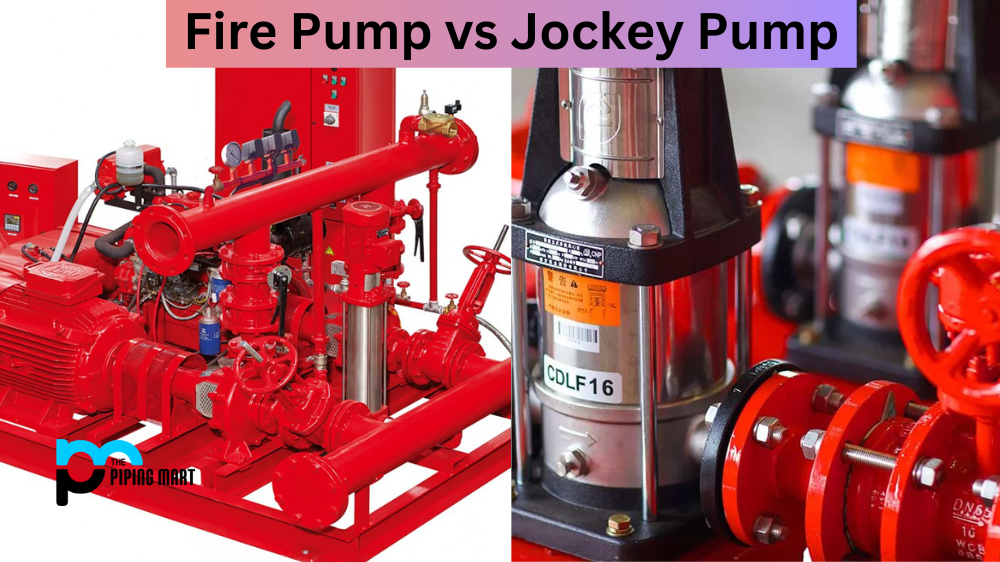In any building, safety is a top priority. A properly functioning fire protection system is crucial in ensuring that the occupants of a building are protected from fire damage. Fire and jockey pumps may sound like devices straight out of a firefighter’s toolkit, but they are essential components of a building’s fire protection system. Understanding the difference between these two types of pumps is crucial in ensuring that your building is up to code. In this blog post, we’ll be delving into the specific functions of fire and jockey pumps and what sets them apart.
Fire Pumps
Fire pumps and jockey pumps perform different yet equally important functions. Fire pumps help to supply water to fire suppression systems such as sprinklers, standpipes, or fire hydrants. They are installed in buildings to maintain water pressure in the system when water demand exceeds the capacity of the water supply. In the event of a fire, the fire pump automatically starts when the pressure in the system drops below a predetermined level to ensure sufficient water is available to the sprinkler system to extinguish the fire. Fire pumps are rigorously tested to ensure reliable and efficient operation.
Jockey Pumps
On the other hand, jockey pumps are small pumps specifically designed to maintain pressure in a fire protection system during non-emergency conditions. They are responsible for maintaining a consistent water supply pressure in the system, ensuring the fire pump does not start unnecessarily. Jockey pumps create and stop automatically according to the system’s water demand. They are commonly used with multiple levels or large horizontal sprinkler systems.
Difference Between Fire Pump and Jockey Pump
The main difference between a fire pump and a jockey pump is that fire pumps are high-capacity pumps that can handle higher pressures and flows. In contrast, jockey pumps are smaller, low-capacity pumps that operate efficiently at lower pressures and flows. To clarify, fire pumps can tap deep water sources, such as lakes or canals, to provide the necessary water flow to multiple building floors. Conversely, jockey pumps could not provide an adequate flow rate at the necessary pressure for those higher floors.
Other differences between the two pumps relate to maintenance and operation. To ensure they operate correctly in emergencies, fire pumps require frequent testing and maintenance, including weekly, monthly, and annual inspections. Jockey pumps only require minimal maintenance and inspection, usually three times a year, since they operate during non-emergency conditions.
- A fire pump is a type of pump that is specifically designed to pump water to extinguish a fire.
- A jockey pump is a type of pump that is typically used to maintain water pressure in a fire sprinkler system.
- Fire pumps are typically larger than jockey pumps.
- Fire pumps typically have a higher flow rate than jockey pumps.
- Jockey pumps typically have a higher pressure than fire pumps.
- An electric motor typically powers fire pumps, while a gasoline engine powers jockey pumps.
- Fire pumps are typically used to provide water for fire hoses, while jockey pumps are typically used to provide water for fire sprinklers.
- Fire and jockey pumps are both important components of a fire protection system.
Conclusion:
In conclusion, fire and jockey pumps provide adequate water for a building’s fire protection system. While they may appear similar, understanding their functions is crucial to know which of the two pumps would suit the type of building in question. Regular maintenance and inspection of both types of pumps are essential to guarantee reliable and efficient operation when needed. To ensure your building’s fire protection system is functioning correctly, consider consulting a fire protection professional for the most effective solution.

Abhishek is a seasoned blogger and industry expert, sharing his insights and knowledge on various topics. With his research, Abhishek offers valuable insights and tips for professionals and enthusiasts. Follow him for expert advice on the latest trends and developments in the metal industry.




